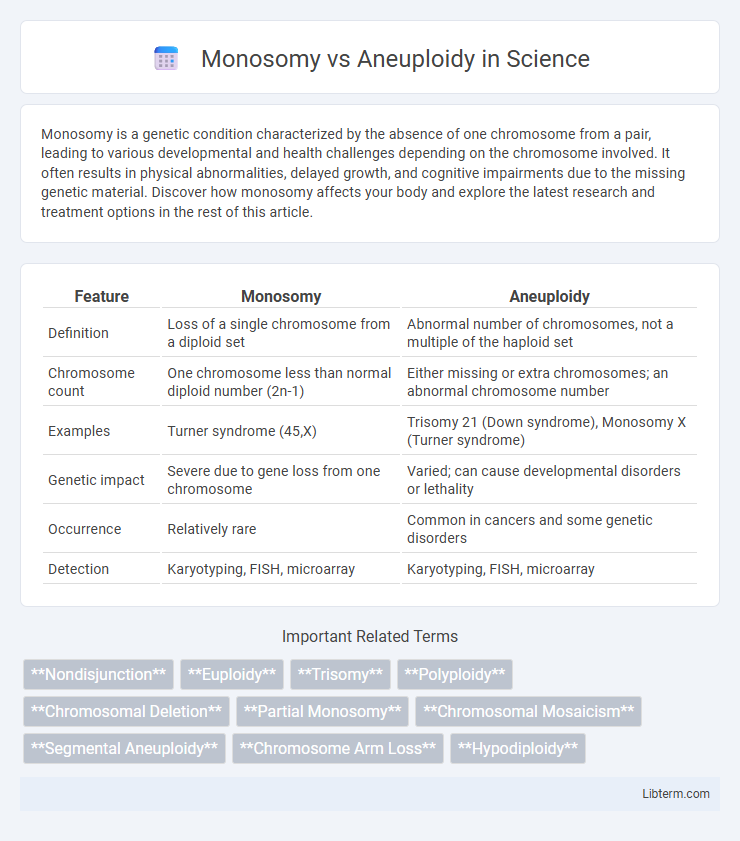Monosomy is a genetic condition characterized by the absence of one chromosome from a pair, leading to various developmental and health challenges depending on the chromosome involved. It often results in physical abnormalities, delayed growth, and cognitive impairments due to the missing genetic material. Discover how monosomy affects your body and explore the latest research and treatment options in the rest of this article.
Table of Comparison
| Feature | Monosomy | Aneuploidy |
|---|---|---|
| Definition | Loss of a single chromosome from a diploid set | Abnormal number of chromosomes, not a multiple of the haploid set |
| Chromosome count | One chromosome less than normal diploid number (2n-1) | Either missing or extra chromosomes; an abnormal chromosome number |
| Examples | Turner syndrome (45,X) | Trisomy 21 (Down syndrome), Monosomy X (Turner syndrome) |
| Genetic impact | Severe due to gene loss from one chromosome | Varied; can cause developmental disorders or lethality |
| Occurrence | Relatively rare | Common in cancers and some genetic disorders |
| Detection | Karyotyping, FISH, microarray | Karyotyping, FISH, microarray |
Understanding Chromosomal Abnormalities
Monosomy is a type of chromosomal abnormality where one chromosome from a pair is missing, resulting in 45 chromosomes instead of the typical 46 in humans. Aneuploidy refers to any deviation from the normal chromosome number, including both monosomy and trisomy, where there is an extra chromosome. Understanding chromosomal abnormalities is critical for diagnosing genetic disorders like Turner syndrome (monosomy X) and Down syndrome (trisomy 21), which arise from such irregularities in chromosome number.
What is Monosomy?
Monosomy is a type of chromosomal abnormality characterized by the absence of one chromosome from a pair, resulting in a single copy instead of the usual two. This condition leads to genetic imbalance and can cause developmental disorders or lethality depending on the affected chromosome. Monosomy is a specific form of aneuploidy, which encompasses any deviation from the normal chromosome number.
Defining Aneuploidy
Aneuploidy is a chromosomal abnormality characterized by the presence of an abnormal number of chromosomes, which can involve either an extra chromosome or a missing one. Monosomy is a specific type of aneuploidy where a single chromosome is missing from a pair, resulting in a total chromosome number of 2n-1. This condition disrupts gene dosage and can lead to developmental and physiological abnormalities in affected organisms.
Key Differences Between Monosomy and Aneuploidy
Monosomy is a specific type of aneuploidy characterized by the absence of one chromosome from a homologous pair, resulting in a single chromosome instead of two. Aneuploidy broadly refers to any deviation from the normal chromosome number, including both monosomy and trisomy. Key differences lie in monosomy representing the loss of one chromosome pair member, while aneuploidy encompasses any numerical chromosome imbalance beyond the standard diploid number.
Causes of Monosomy
Monosomy occurs when a single chromosome is missing from the normal diploid set, typically caused by nondisjunction during meiosis, leading to an unequal distribution of chromosomes in the gametes. Aneuploidy includes any abnormal number of chromosomes, such as monosomy or trisomy, resulting from errors in chromosome segregation. Causes of monosomy are often linked to mutations or malfunctions in the spindle apparatus, defective cohesion proteins, or environmental factors that disrupt proper chromosomal separation.
Common Types of Aneuploidy
Monosomy is a type of aneuploidy characterized by the loss of a single chromosome, resulting in a 2n-1 chromosome count, with Turner syndrome (45,X) being a well-known example. Aneuploidy broadly refers to any deviation from the normal chromosome number, including monosomy, trisomy, and other numerical abnormalities. Common types of aneuploidy include trisomy 21 (Down syndrome), trisomy 18 (Edwards syndrome), trisomy 13 (Patau syndrome), and sex chromosome aneuploidies such as Klinefelter syndrome (47,XXY) and Triple X syndrome (47,XXX).
Clinical Features of Monosomy
Monosomy, a type of aneuploidy characterized by the absence of one chromosome from a pair, often results in severe clinical features such as developmental delays, growth retardation, and congenital abnormalities. Common monosomies include Turner syndrome (45,X), which presents with short stature, gonadal dysgenesis, and cardiovascular defects. The clinical severity and manifestations of monosomy depend on which chromosome is missing and the degree of gene dosage imbalance.
Health Implications of Aneuploidy
Aneuploidy, the presence of an abnormal number of chromosomes, often leads to significant health implications including developmental delays, congenital disabilities, and increased risk of certain cancers. Monosomy, a type of aneuploidy characterized by the loss of a single chromosome, typically results in severe phenotypic abnormalities, such as Turner syndrome caused by monosomy X. The broad spectrum of aneuploidy-related disorders underscores the critical role of chromosomal balance in maintaining genomic stability and overall health.
Diagnostic Techniques for Detecting Chromosomal Disorders
Diagnostic techniques for detecting monosomy and aneuploidy include karyotyping, which visualizes chromosome number and structure under a microscope, and fluorescence in situ hybridization (FISH), enabling targeted identification of specific chromosomal abnormalities. More advanced methods such as chromosomal microarray analysis (CMA) provide high-resolution detection of copy number variations and submicroscopic deletions or duplications. Non-invasive prenatal testing (NIPT) analyzes cell-free fetal DNA in maternal blood, offering a rapid and accurate screening tool for common aneuploidies including monosomy X.
Prevention and Management Strategies
Preventing monosomy and aneuploidy involves genetic counseling and early prenatal screening techniques such as non-invasive prenatal testing (NIPT) to identify chromosomal abnormalities. Management strategies include targeted medical interventions, supportive therapies, and personalized care plans to address developmental delays and health complications associated with these chromosomal disorders. Advances in reproductive technologies, including preimplantation genetic diagnosis (PGD), play a critical role in reducing the incidence of aneuploidy in high-risk populations.
Monosomy Infographic

 libterm.com
libterm.com